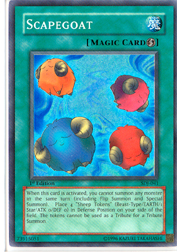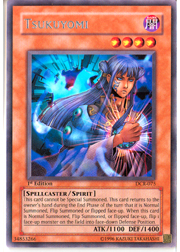 The recent ruling changes on battle position have given rise to yet another “sinister new force.” Previously, decks that focused on Scapegoat were at the forefront of the North American metagame. Every competitive deck automatically features multiple copies of the fuzzy sheep token generators, and every single player in the Top 8 of Shonen Jump New Jersey relied on at least two Scapegoats in their defense.
The recent ruling changes on battle position have given rise to yet another “sinister new force.” Previously, decks that focused on Scapegoat were at the forefront of the North American metagame. Every competitive deck automatically features multiple copies of the fuzzy sheep token generators, and every single player in the Top 8 of Shonen Jump New Jersey relied on at least two Scapegoats in their defense.
However, the recent announcements that bring the United States game in line with its Asian counterpart have created new ways of exploiting synergies. The use of Tsukuyomi with many different options, such as Magician of Faith and Metamorphosis, has increased. It’s also no secret that the Scapegoat and Tsukuyomi Chaos deck has been dominating the Japanese game for years.
Pulverizing the Scapegoat Engine
Many of the decks that have placed highly in recent Shonen Jump Championships appear fundamentally sound and balanced—hence the widespread use of these builds. Fortunately, decks revolving around Scapegoat and monsters with low DEF and great effects have a few drawbacks that can easily be exploited. Keep in mind that decks that revolve around combos lose their effectiveness once their options are limited.
Obviously, trampling monsters can completely devastate these decks. A tribute monster, such as Mefist the Infernal General, can be used to quickly reduce your opponent’s life points. The game is rife with numerous examples of great tribute monsters. The aforementioned Mefist the Infernal General, Enraged Battle Ox, Big Bang Shot, and the obvious Airknight Parshath (which is already used by almost every competitive duelist) are all excellent choices against Scapegoat decks.
Next, there are monsters that can simply negate the board presence of weaker monsters. King Tiger Wanghu and Asura Priest are two great monsters with solid ATK that can exploit Scapegoat and other cards like it. Keep in mind that decks revolving around multiple copies of Scapegoat are generally trying to draw out resources while biding their time. Increasing the speed and tempo of the game by causing trample damage and sweeping the opponent’s field of defensive cards will definitely work out well.
Stopping Mike Rosenberg's Baby in its Tracks
 As for the dreaded moon diviner, keep in mind that any Tsukuyomi user is actually willingly exchanging board presence for card advantage. Each summon of Tsukuyomi does very little to affect the field, since it returns to the hand during the end phase. Exploit this with all sorts of cards that will press the attack, such as Don Zaloog and Masked Sorcerer.Almost any monster that has an effect triggered by battle damage, including Cliff the Trap Remover, can also be used as a means of punishing the Tsukuyomi player.
As for the dreaded moon diviner, keep in mind that any Tsukuyomi user is actually willingly exchanging board presence for card advantage. Each summon of Tsukuyomi does very little to affect the field, since it returns to the hand during the end phase. Exploit this with all sorts of cards that will press the attack, such as Don Zaloog and Masked Sorcerer.Almost any monster that has an effect triggered by battle damage, including Cliff the Trap Remover, can also be used as a means of punishing the Tsukuyomi player.
Other great monsters to consider are those in the 1800 ATK family tree. Kycoo the Ghost Destroyer and D. D. Survivor are both great pieces of tech: the first will control the graveyard, eliminating the inevitable summon of Black Luster Soldier – Envoy of the Beginning, and the second can counter Bottomless Trap Hole, D. D. Warrior Lady, and D. D. Assailant.
There are numerous monsters with great defense that can counter Tsukuyomi’s effect as well. Skilled Dark Magician, D. D. Assailant, Strike Ninja, and other cards like them can all be used quite effectively.
Other Subtle Modes of Disruption
The rest of the focus should be placed on disrupting the combo capabilities of Tsukuyomi by using cards that can limit the amount of resources generated within the game. In particular, Time Seal and Magic Drain are great—they force one-for-one trades with your opponent. Any sort of early advantage that you can gain will be amplified by these cards.
There are many other examples of trades like these. Spell Shield Type 8 can stop Book of Moon, Enemy Controller, Snatch Steal, and other linchpins of the Tsukuyomi defense. Exiled Force will trade with one of your opponent’s monsters, as will the obligatory two copies of Nobleman of Crossout.
Once again, the golden rule for stopping a combo deck is to limit its access to its resources. Thankfully, Yu-Gi-Oh! provides a variety of ways to accomplish this goal. Feel free to explore to your heart’s content.
There is an X Factor
Obviously, the initiative to counter Scapegoat-based Chaos decks has been in place since the beginning of the new Advanced format season. However, the reason that so many skilled players have failed to do so lies in the fact that the framework of the deck is both solid and consistent.
When two players of an equal skill level are paired up, the decisive factor in finding the winner of the match is often the quality of each player’s draw. Combo decks tend to suffer from bad draws more frequently than these Scapegoat decks do, so any counters to them must achieve a similar level of consistency and stability in order to dominate the upper echelon of Yu-Gi-Oh! events.
Hopefully some of the options listed in this article, and some derived from your own experience, will tip the balance and help achieve victory against the multitude of Tsukuyomi-based Chaos decks.
Metagame.com covers a living, breathing entity that is constantly evolving, changing, and developing, often at rapid speeds. The Top 8 at one Shonen Jump Championship might feature Soul Exchange and Tsukuyomi, while another may feature Armed Samurai – Ben Kei and Spell Canceller. A single duelist cannot hope to predict the entire lineup of the future, but he or she can certainly prepare for the inevitable matchup against a Scapegoat and Tsukuyomi Chaos deck.